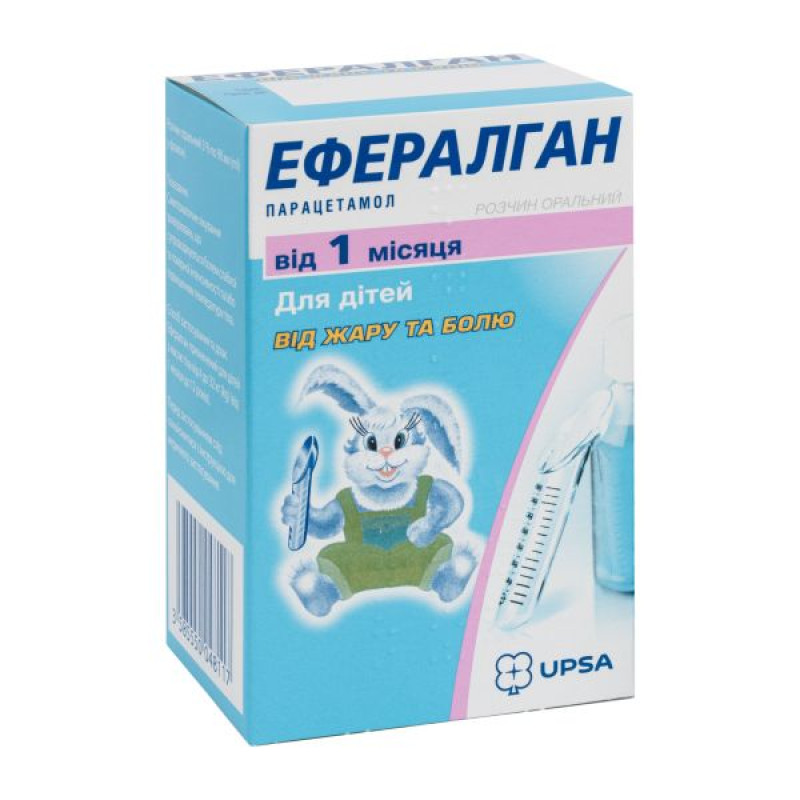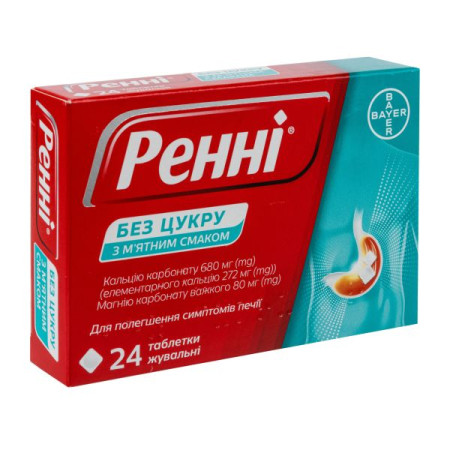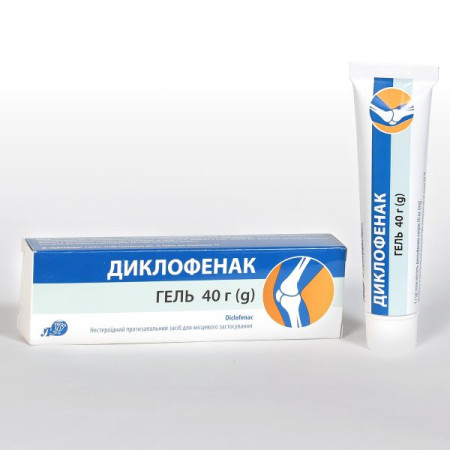Efferalgan oral solution 3% bottle 90 ml

Instructions Efferalgan oral solution 3% bottle 90 ml
Composition
active ingredient: paracetamol;
1 ml of oral solution contains 30 mg of paracetamol;
excipients: macrogol 6000, sucrose solution, sodium saccharin, potassium sorbate, anhydrous citric acid, caramel-vanilla flavoring, purified water.
Dosage form
Oral solution.
Main physicochemical properties: slightly viscous brown solution with a caramel-vanilla odor.
Pharmacotherapeutic group
Analgesics and antipyretics. Paracetamol. ATX code N02B E01.
Pharmacological properties
Pharmacodynamics
It has analgesic, antipyretic and weak anti-inflammatory effects. The mechanism of action is due to inhibition of prostaglandin synthesis and a predominant effect on the thermoregulation center in the hypothalamus.
Pharmacokinetics
Paracetamol is rapidly and completely absorbed from the gastrointestinal tract after oral administration. The maximum concentration of paracetamol in the blood plasma is reached 30–60 minutes after administration. Paracetamol is metabolized mainly in the liver with the formation of inactive compounds with glucuronic acid and sulfates.
Excreted mainly in the urine. 90% of the administered dose of paracetamol is excreted by the kidneys within 24 hours, mainly in the form of glucuronide and sulfate conjugates. Less than 5% is excreted unchanged. The half-life is approximately 2 hours.
Indication
Symptomatic treatment of diseases accompanied by pain of mild to moderate intensity and/or fever.
Contraindication
Hypersensitivity to paracetamol or to other components of the drug.
Severe renal and/or hepatic dysfunction, congenital hyperbilirubinemia, glucose-6-phosphate dehydrogenase deficiency, alcoholism, blood diseases, severe anemia, leukopenia.
Special safety precautions
Do not use the drug in children together with other products containing paracetamol.
When treating with paracetamol at a dose of 60 mg/kg/day, concomitant use of another antipyretic is justified only in case of ineffectiveness of paracetamol. The recommended doses should not be exceeded.
The drug contains sucrose, which should be taken into account by patients with fructose intolerance, glucose-galactose malabsorption and/or sucrose-isomaltose malabsorption. If the symptoms of the disease do not disappear within 3 days of treatment with the drug or, conversely, the health condition worsens, you should consult a doctor.
Interaction with other medicinal products and other types of interactions
When taking maximum doses of paracetamol (4 g/day) for at least 4 days, there is a risk of potentiation of the effect of the oral anticoagulant and an increased risk of bleeding. The INR (International Normalized Ratio) should be monitored at regular intervals. If necessary, the dose of the oral anticoagulant should be adjusted during treatment with paracetamol.
The rate of absorption of paracetamol may increase when combined with metoclopramide and domperidone and decrease with cholestyramine. Barbiturates reduce the antipyretic effect of paracetamol. Anticonvulsants (including phenytoin, barbiturates, carbamazepine), which stimulate the activity of liver microsomal enzymes, may enhance the toxic effect of paracetamol on the liver due to an increase in the degree of conversion of the drug to hepatotoxic metabolites. With simultaneous use of paracetamol with hepatotoxic agents, the hepatotoxic effect of the drug on the liver increases. Simultaneous use of high doses of paracetamol with isoniazid, rifampicin increases the risk of developing hepatotoxic syndrome. Paracetamol reduces the effectiveness of diuretics. Do not use simultaneously with alcohol.
High concentrations of paracetamol may affect laboratory results of blood glucose determination using the oxidase-peroxidase method and uric acid determination using the phosphotungstic acid method.
Caution should be exercised when using paracetamol and flucloxacillin simultaneously, as concomitant administration is associated with metabolic acidosis with a high anion gap, especially in patients at risk ("Special warnings and precautions for use").
Application features
In patients with severe infections, such as sepsis, which are accompanied by decreased glutathione levels, the risk of metabolic acidosis is increased when taking paracetamol.
Symptoms of metabolic acidosis include deep, rapid, or labored breathing, nausea, vomiting, and loss of appetite. You should seek immediate medical attention if you experience these symptoms.
Use with caution in patients with body weight up to 50 kg, chronic malnutrition (low glutathione stores in the liver), dehydration, mild to moderate liver failure.
Caution is advised when paracetamol and flucloxacillin are used concomitantly due to the increased risk of developing metabolic acidosis with a high anion gap, especially in patients with severe renal insufficiency, sepsis, malnutrition and other sources of glutathione deficiency (e.g. chronic alcoholism), as well as those taking maximum daily doses of paracetamol. Close monitoring, including measurement of urinary 5-oxoproline, is recommended.
Use during pregnancy or breastfeeding
The drug is intended for use in pediatric practice.
A large amount of data on pregnant women indicate neither malformations nor feto/neonatal toxicity. Epidemiological studies on the development of the nervous system in children exposed to paracetamol in utero show inconclusive results. If clinically necessary, paracetamol can be used during pregnancy at the lowest effective dose for the shortest duration and with the least possible frequency.
Traditional studies using currently accepted standards for assessing reproductive and developmental toxicity are lacking.
Ability to influence reaction speed when driving vehicles or other mechanisms
The drug is intended for use in pediatric practice.
Method of administration and doses
Efferalgan is intended for children weighing from 4 to 32 kg (from 1 month to 12 years).
A single dose of paracetamol is 15 mg/kg body weight. The daily dose of paracetamol should not exceed 60 mg/kg body weight per day. The interval between doses of the drug should be at least 6 hours. In severe renal failure (creatinine clearance less than 10 ml/min), the interval between doses should be at least 8 hours.
Table 1 provides data on the use of the drug:
Table 1
| Child's age | The average body weight of a child at the appropriate age is approximately* | Number per reception | Daily dose when taken 4 times a day |
| 1-2 months | 4 kg | 60 mg | 240 mg |
| 3-5 months | 6 kg | 90 mg | 360 mg |
| 6-10 months | 8 kg | 120 mg | 480 mg |
| 11-12 months | 10 kg | 150 mg | 600 mg |
| 2 years | 12 kg | 180 mg | 720 mg |
| 3 years | 14 kg | 210 mg | 840 mg |
| 4-5 years | 16 kg | 240 mg | 960 mg |
| 6-7 years | 20-24 kg | 300-360 mg | 1200-1440 mg |
| 8-9 years old | 26-30 kg | 390-450 mg | 1560-1800 mg |
| 10-12 years | 30-32 kg | 450-480 mg | 1800-1920 mg |
* Before using the drug, the child must be weighed to prevent overdose and avoid the toxic effects of the drug.
The measuring spoon has divisions corresponding to a mass of 4-6-8-10-12-14-16 kg.
Additional divisions correspond to intermediate body weight: 3-5-7-9-11-13-15 kg.
The drug can be used undiluted or diluted in a small amount of liquid (e.g. water, milk, fruit juice).
Fill the measuring spoon according to the child's body weight and adjust the liquid level depending on the divisions.
From 4 to 16 kg: use a measuring spoon with divisions according to the child's body weight or use the division that corresponds to the closest to the child's body weight.
For example, from 4 kg to 5 kg: fill the measuring spoon to the 4 kg mark. If necessary, the dose can be repeated after 6 hours.
From 16 to 32 kg: first fill the measuring spoon, then adjust to the required amount by filling the measuring spoon a second time, until the child's body weight is obtained.
For example, from 18 to 19 kg: first fill the measuring spoon to the 10 kg mark, and then, a second time, fill to the 8 kg mark. If necessary, the drug can be repeated after 6 hours.
If pain or fever persists or worsens within 3 days of starting treatment with the drug, the appropriateness of further use of the drug should be reconsidered.
Children.
The drug should be used in children weighing from 4 to 32 kg (from 1 month to 12 years).
Overdose
To avoid overdose, you should check that other medicines do not contain paracetamol.
There is a risk of serious poisoning in the elderly, young children, patients with liver damage, chronic alcoholism, and patients with chronic malnutrition. This can be fatal.
In children weighing less than 37 kg, the total dose of paracetamol should not exceed 80 mg/kg/day.
In children weighing 38 kg to 50 kg, the total dose of paracetamol should not exceed 3 g/day.
A single dose of 10 g for an adult and 150 mg/kg of body weight for a child can cause hepatocellular insufficiency, impaired glucose metabolism, metabolic acidosis, hemorrhages, hypoglycemia, encephalopathy, coma, and death. At the same time, the level of hepatic transaminase, lactate dehydrogenase, and bilirubin increases, and the prothrombin level decreases within 12–48 hours. Acute renal failure with acute tubular necrosis can manifest as severe pain in the lumbar region, hematuria, and proteinuria and develop even in the absence of severe liver damage. Cardiac arrhythmia and pancreatitis have also been noted. With prolonged use of the drug in high doses, aplastic anemia, pancytopenia, agranulocytosis, neutropenia, leukopenia, and thrombocytopenia may develop from the hematopoietic system. When taking large doses from the CNS - dizziness, psychomotor agitation and disorientation; from the urinary system - nephrotoxicity (renal colic, interstitial nephritis, papillary necrosis); from the digestive system - hepatonecrosis. In patients with risk factors (long-term use of carbamazepine, phenobarbitone, phenytoin, primidone, rifampicin, St. John's wort or other drugs that induce liver enzymes; alcohol abuse; insufficiency of the glutathione system, for example, malnutrition, AIDS, starvation, cystic fibrosis, cachexia), the use of 5 g or more of paracetamol can lead to liver damage. Liver damage may become apparent 12–48 hours after an overdose. In case of overdose, the patient should be taken to the hospital immediately, even if there are no early symptoms of overdose. Symptoms of overdose appear within the first 24 hours: nausea, vomiting, decreased appetite, pallor, abdominal pain, or may not reflect the severity of the overdose or the risk of damage. Emergency measures:
immediate hospitalization;
determination of paracetamol levels in blood plasma;
gastric lavage;
administration of the antidote N-acetylcysteine intravenously or methionine orally within the first 10 hours;
symptomatic therapy.
Side effects
Very rare:
allergic reactions: anaphylaxis, anaphylactic shock, angioedema, erythema, urticaria, skin itching, rash on the skin and mucous membranes, exudative erythema multiforme, toxic epidermal necrolysis;
on the part of the hematopoietic organs: anemia, sulfhemoglobinemia and methemoglobinemia (cyanosis, shortness of breath, heart pain), hemolytic anemia, thrombocytopenia, leukopenia and neutropenia, bruising or bleeding;
Respiratory system: bronchospasm in patients sensitive to aspirin and other NSAIDs;
from the digestive system: nausea, epigastric pain, liver dysfunction, increased activity of liver enzymes, usually without the development of jaundice, hepatonecrosis (dose-dependent effect);
From the endocrine system: hypoglycemia, up to hypoglycemic coma.
Sometimes malaise and decreased blood pressure, renal colic are possible.
If any adverse reactions occur, you should stop using the drug and be sure to consult a doctor.
Expiration date
3 years. Shelf life after first opening the bottle: 3 months.
Storage conditions
Store at a temperature not exceeding 25 °C out of the reach of children.
Packaging
90 ml of oral solution in a bottle. 1 bottle complete with a measuring spoon in a cardboard box.
Vacation category
Without a prescription.
Producer
UPSA SAS, France.
Address
304, avenue du Docteur Jean Bru, 47000 Agen, France/304, avenue du Docteur Jean Bru, 47000 Agen, France.
There are no reviews for this product.
There are no reviews for this product, be the first to leave your review.
No questions about this product, be the first and ask your question.


















